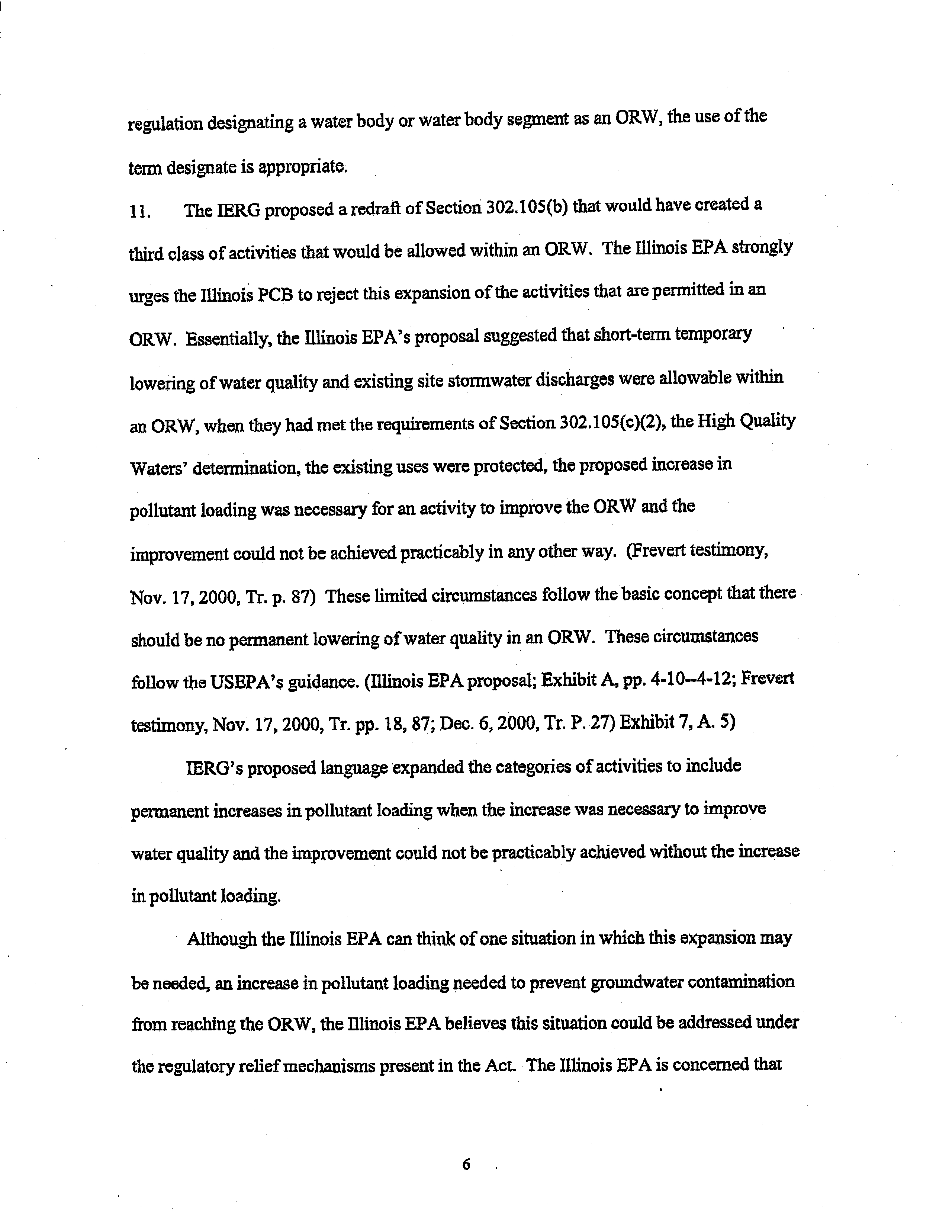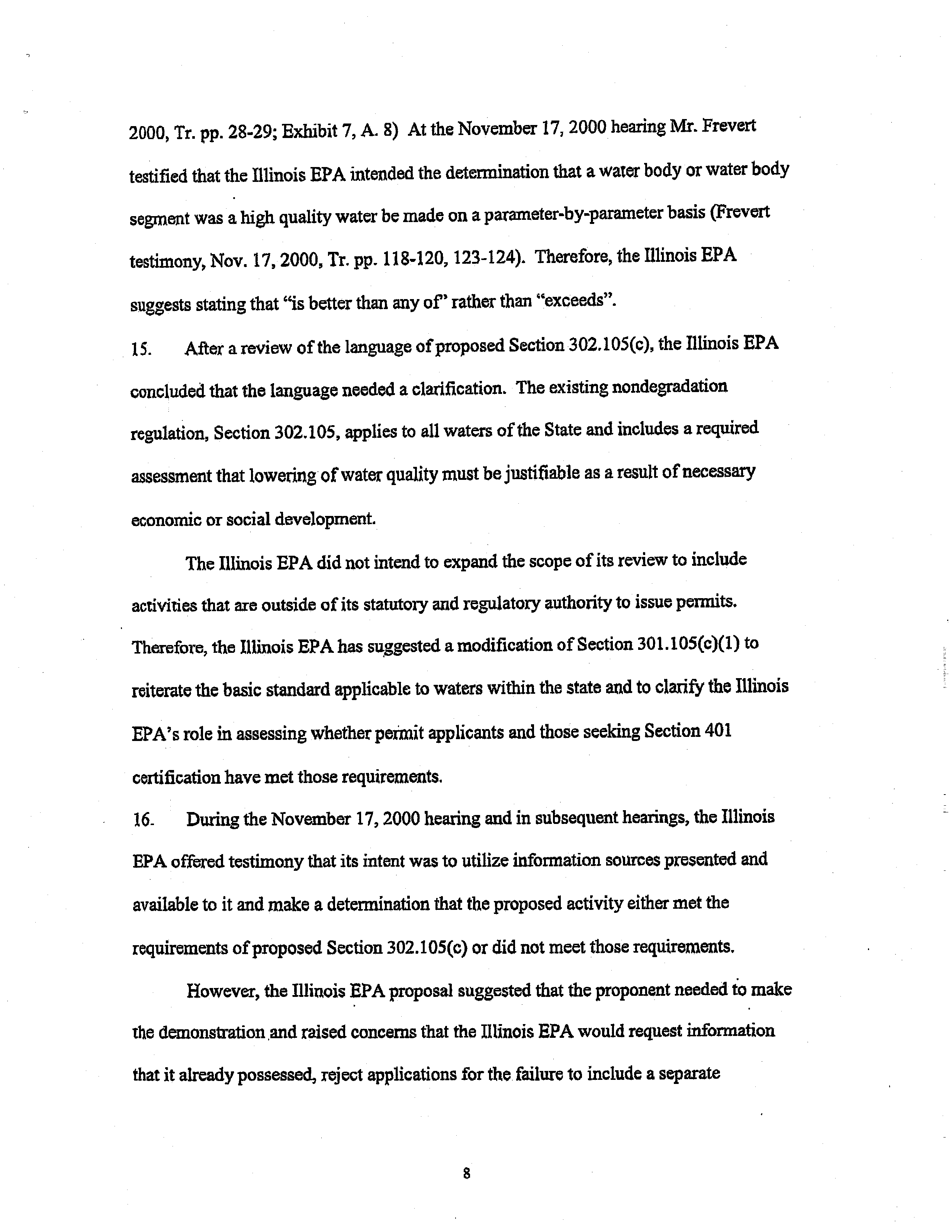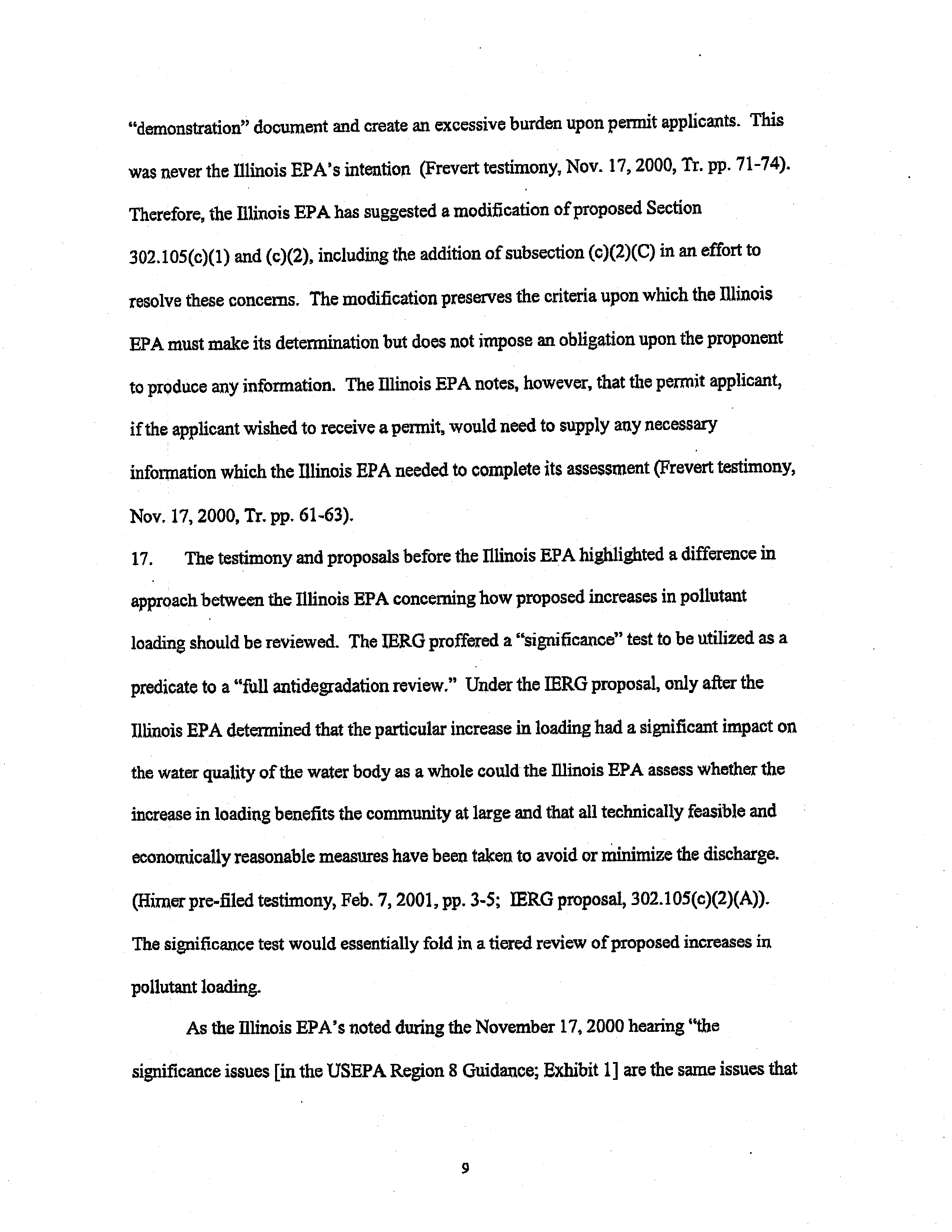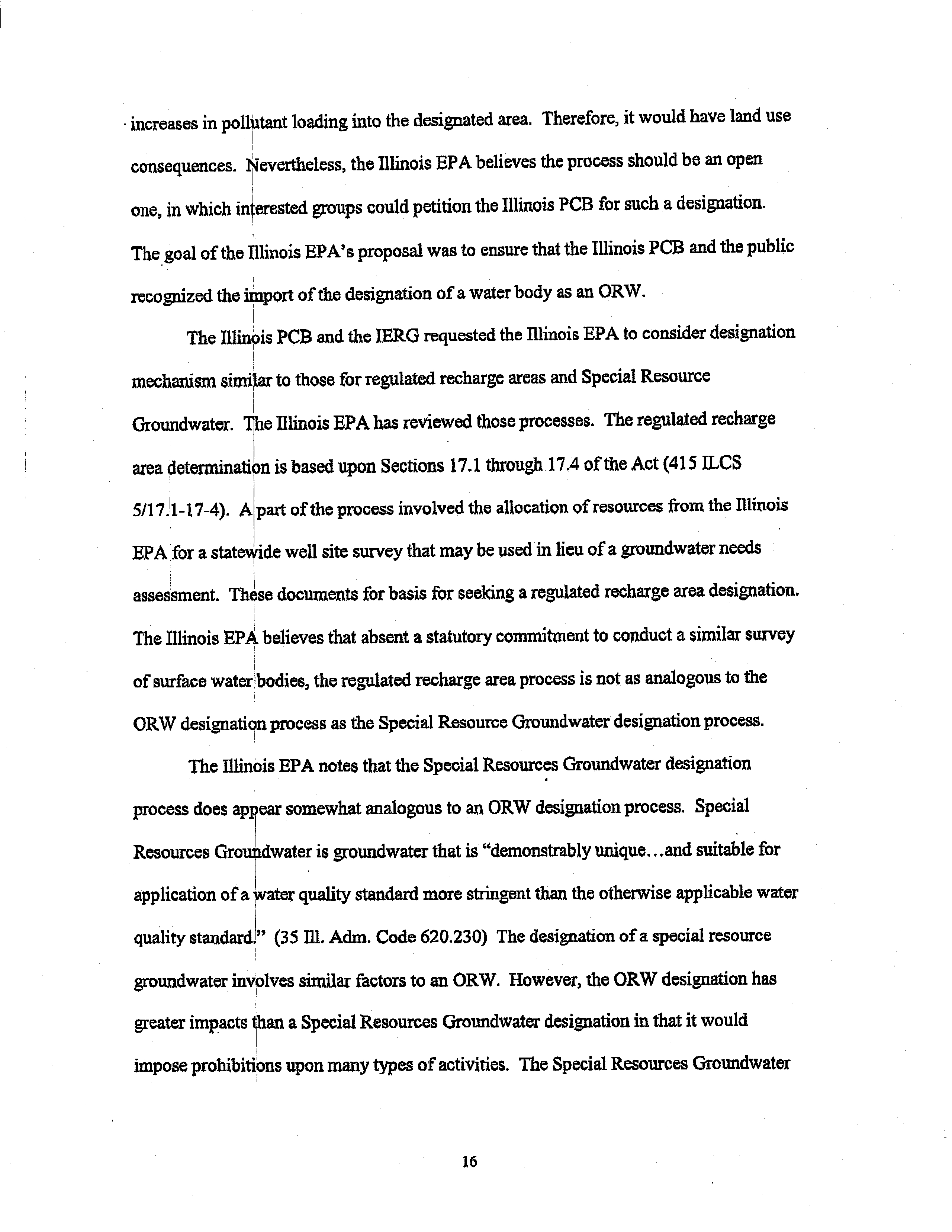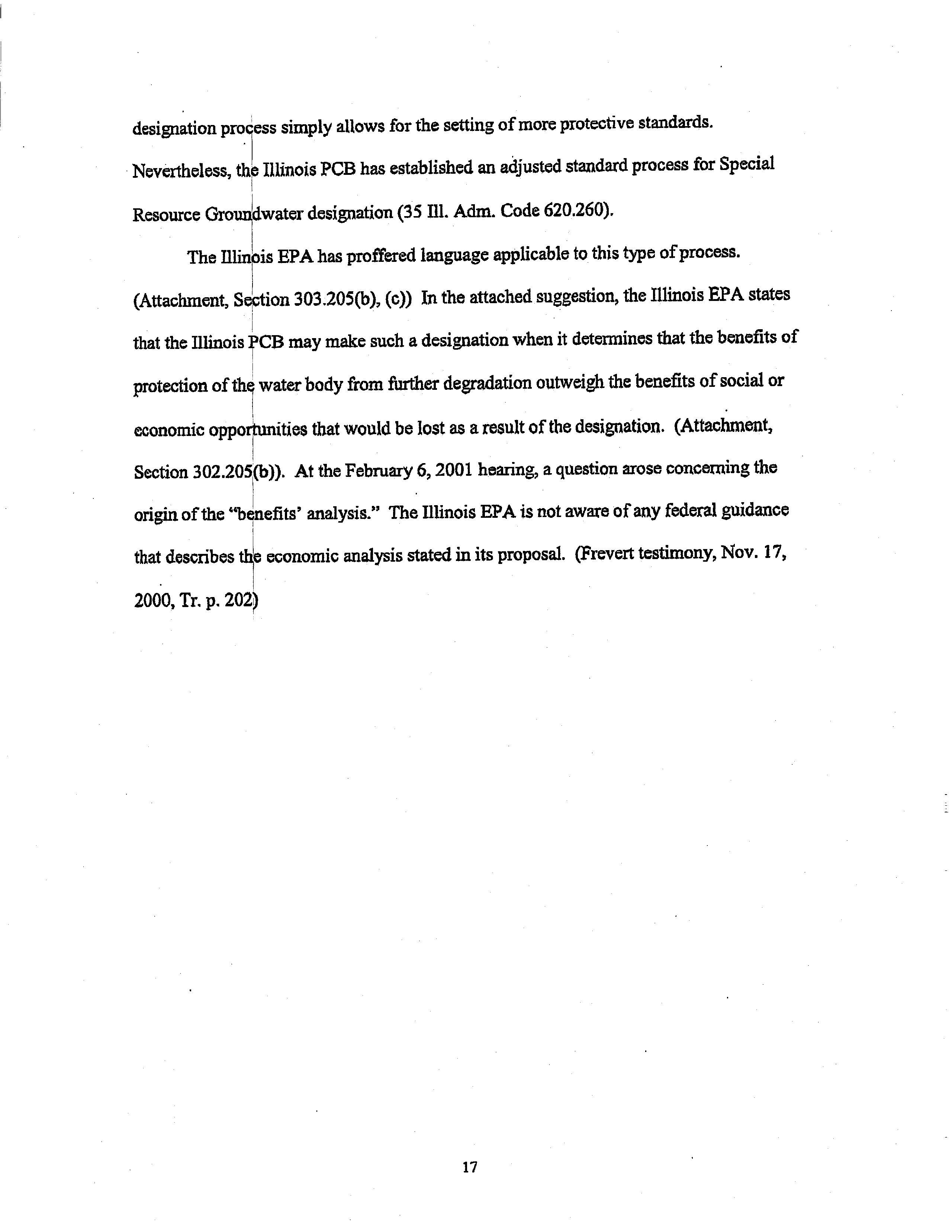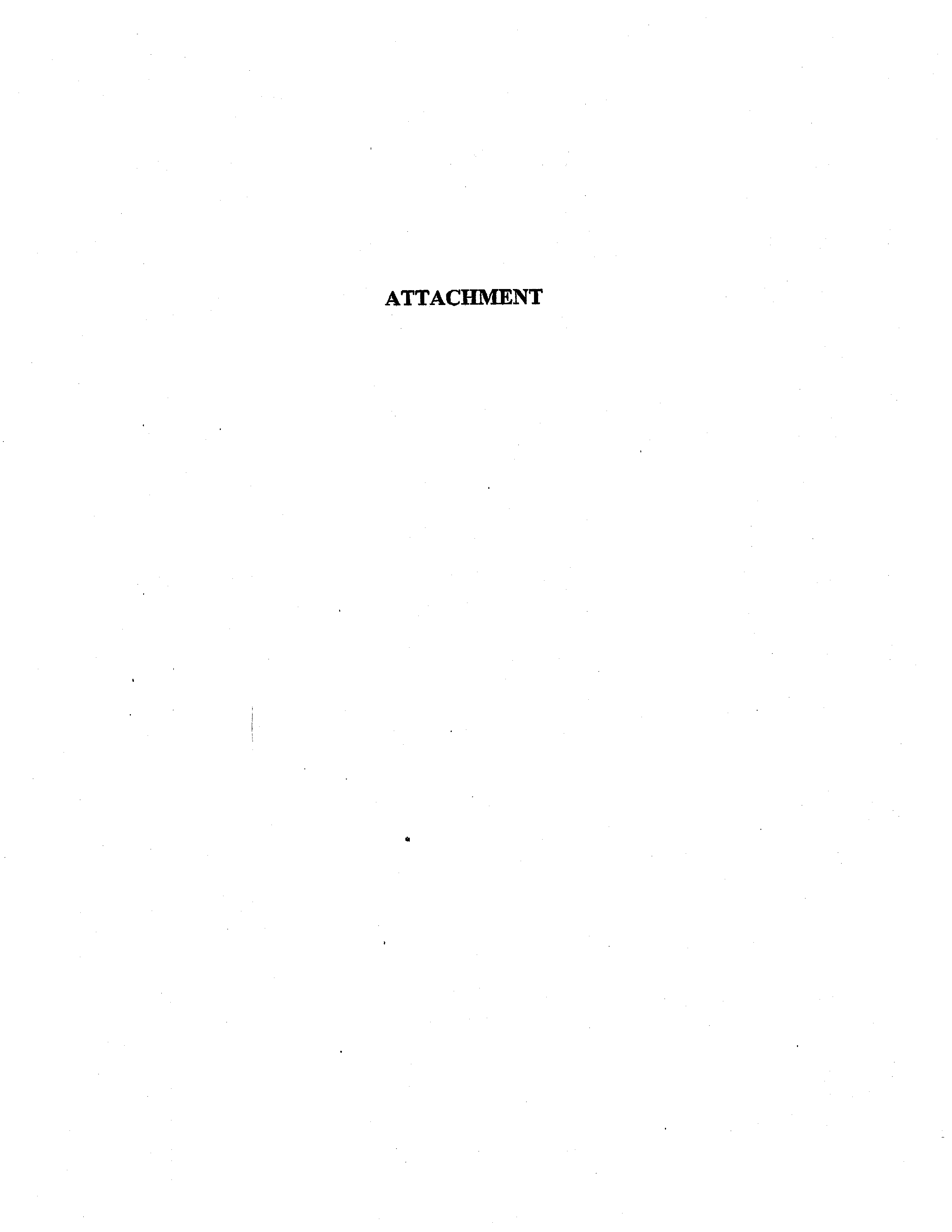RECEIVED
CLERK’S
flF~~’~
MAR
2
0
2~Thi
STATE OF
ILL NOIS
Pollution Control Board
IN THE MATTER OF:
REVISIONS TO ANTIDEGRADATION
RULES:
35 ILL. ADM. CODE 302.105,
303.205,
303.206, and 106.990-106.995
)
)
)
)
)
)
RO
1-13
(Rulemaking-Water)
NOTICE OF FILING
Dorothy M. Gwm, Clerk
Ilhn~is Pollution Control Board
James R. Thompson Center
100 West RandolphStreet,
Suite-
11-500
Chicago, Illinois 60601
(VIA Facsimile followed by U. S. Mail)
AND THE ATTACHED SERVICE LIST
(Via U. S. Mail)
Marie E. Tipsord
Hearing Officer
Illinois Pollution Control Board
100 West RandolphSt. Suite 11-500
Chicago, Illinois 60601
(VIA Facsimile followed by U. S. Mail)
PLEASE TAKE NOTICE that I have today filed with the Office of the Clerk of the ?ollurion Control
Board the Closing Coimnents, with Attachment, of
the Illinois Environmental Protection Agency, acopy ofwhich
is herewith served upon you.
ENVIRONMENTAL PROTECTION AGENCY
OF THE STATE OF ILLINOIS
By:
~
Conute L
Tonsor
Associate Counsel
DivisionofLegal Counsel
DATED: March 20, 2001
illinois Environmental Protection Agency
1021
North GrandAvcnue East
Post Office Bolt 19276
Springfield, illinois 62794-9276
(217) 782-5544
ILLINOiS POLLUTION CONTROL BOARD
THIS FILING IS SUBMITTED ON RECYCLED PAPER
CLE~j~’~
0PPICE
BEFORE THE ILLINOIS POLLUTION CONTROL BOARD
MAR
2
0
2001
STATE OP
ILLINOIS
iN THE MATTER OF:
)
PC)llUtlOfl
Contro;
Board
)
REVISIONS TO ANTIDEGRADATION
)
RO1-13
RULES:
35111. Adm. Code 302.105,
)
(Rulemaking-Water)
303.205, 303.206, and 106.990-106.995
)
and 35111.
Adxn. Code 106.990 through 106.995.
)
CLOSING COMMENTS
NOW COMES the Illinois Environmental Protection Agency (“IllinoisEPA”). by
one of its attorneys, Connie
L.
Tonsor
and hereby submits
its
Closing Comments and
suggestions for amended language (Attachment A).
1.
On
August
30,
2000,
the
Illinois
EPA
filed
the
instant
petition
proposing
amendments
to
the
antidegradation
regulations,
the establishment
of designation
of
Outstanding Resource Waters (“ORW”) bythe Illinois Pollution Control Board (Illinois
PCB”) and the ertablishment ofa procedure by the Illinois PCB for ORW designation.
2.
The illinois PCB held hearings on the proposal on November 17, 2000, December
6, 2000 and ~
6, 2001.
As notedby the illinois EPA in its Statement ofReasons,
the instant rul¶Iaking
was
developed
over
a more than
two-year
period.
During this
time the Illinois~EPAmet with and discussed various proposals with a workgroup.
The
Illinois EPA
appreciates the
effort and the
concern
expressed by
the members of the
workgroup, many ofwhom participated in the hearings before the illinois PCB.
3.
The
efforts of the workgroup
and the Illinois
EPA resulted
in
a
proposal that
contained many ~.reasofagreement as to the approach and the need for amendment ofthe
existing regulation.
A5 the Illinois ~PA
noted when ~tproposed the instant amendments,
its
proposal was
one,
which the illinois
EPA believed
workable, from an Illinois
EPA
resource andtechnical standpoint, and federally approvable.
4.
However, several areas ofdisagreement and lack ofclarity remained.
These areas
became the focus of testimony
and
alternate language proposals from members of the
Illinois
Environmental
Regulatory
Group
(“JERG”),
the illinois Association
of
Wastewater Agencies (“IAWA”), theEnvironmental Law & Policy Center, Friends ofthe
Fox
River, Prairie
Rivers Network, Sierra
Club (“EnviroDmental
Groups”),
and
the
flhinois Department ofNatural Resources (“IDNR”).
5.
Those areas in general involved:
Proposed Section 302.105(a)
(a)
the distinguishing of surface water from groundwater in the applicability
ofthe rules;
(b)
the
extent
of
the
description
of
activities
that
could
constitute
a
degradation ofan existing use;
Proposed Section 302.105(b)
Cc)
whether waters should
be
“classified or designated”
as
ORWs
by
the
illinois PCB;
(d)
the extent ofactivities that should be allowed within an ORW;
Proposed Section 302.105(c)
(e)
whether the proponent of an activity
should demonstrate that the activity
or proposed
increase
in
pollutant
loading
is
necessary
to accommodate
important economic
or
social
development
or the
Illinois
EPA should
make
an
assessment that
the
activity
is
necessary
to
accommodate
important economic or social development;
2
(f)
the information sources that the Illinois EPA
could consider in making its
assessment;
(g)
use
of
an
approach
that
provides
a multi-step,
limited antidegradation
r~view,
depending
upon
the
significance
of the increase
in
pollutant
and the development ofsuch aprocess;
lc~ading,
(ii)
whether
an
existing
permitted
discharge
should
be
subject
to
a
new
a~itidegradation review and the causes for the second review;
Proposed Section 302.105(d)
(i)
tl~e
necessity
for
the inclusion of various
activities
as
exceptions from
fi~ther antidegradationreviews;
(I)
whether the illinois
PCIB should
include a de
minimis determination
to
li~nit an
antidegradation review to those situations in which the increase in
pollutant
loading
is
in
excess
of
10%
of
the
remaining assimilative
in the receiving stream; and
c~pacity
ORW definition and designation
(k)
the fundamental approach that the Board should adopt to
designate water
bodies and waterbody segments as ORWs.
6.
The Illinois PCB also suggested that the Illinois EPA consider:
(1) a designation
process
for
OI~.Ws
similar
to
that
used
in
the
designation
of
Special
Resource
Groundwater,
pursuant
to
35
Ill.
Adm.
Code
620.230
and
620.260;
(2)
consider
the
process for the adoption of aRegulated Recharge Area, pursuant to Section 17.3 and 17.4
of the illinois
~nviromnentalProtection
Act (“Act”). 415 ILCS 5/17.3,
17.4;
and
the
addition ofa new part or subpart, similar to 35
111. Adm. Code 617, to list ORWs.
3
After reviewing the testimony
and comments in
this
proposal, the
Illinois EPA
has
made
several
suggested
language changes.
Those
changes are
appended
to
this
Comment and reflect areas in which the Illinois EPA has clarified the proposal to better
reflect its
i~’itent.
The Comment also suggests an ORW designation process similar to that
adopted by the Illinois PCB
for the reclassification of groundwater as Special Resource
Groundwater.
The Illinois EPA notes, however, that it believes the designation process
should be
as open as possible to
those who
seek designation of a water body or water
body segment as an ORW.
The balance ofthis comment will further discuss these areas.
Proposed
Section 302105
Introductory Language
8.
The Environmental Groups suggested that the introductory language ofproposed
Section 302.105 should include a statement that its purpose is to protect existing uses and
to protect water whose quality is better than water quality standards.
This was its intent
in formulating the proposal; and thus, the Illinois EPA suggests amodification ofthe
introductory language.
Proposed Section 302.105(a)
9.
The
IERG
suggested
that the illinois
PCB clarify that
Section
302.105
did not
apply to
groundwater.
The Illinois EPA believes that this clarification is not needed in
the
instant regulation.
Section
620.301
of the
Illinois
PCB’s regulations
governing
groundwater quabty
(“groundwater regulations”) specifically states the nondegradation
standard for groundwater.
(35 Ill. Adm. Code 620.301) Additionally, Section 620.130 of
the Illinois PCB’sregulations on
groundwater quality
specifically exempt
groundwater
from
the provisions
of
35
III.
Adm.
Code
Subparts
B
and
C.
Although
the
4
antidegradation regulation is a part of 35
Ill. Adm.
Code Subpart A, it references water
quality standards from which groundwater is exempt.
Therefore, the addition of“surface
water body” is
not needed.
However, the IERO’s suggestion that“waterbody segment”
may
clarify that
a water body
may
be
treated
as
a whole
or be broken
into
various
segments for purposes of Section 302.105.
Therefore, the Illinois EPA suggests adding
this language.
9.
The Environmental
Groups
suggested in
their
testimony that
the
examples
of
degradation of existing uses should include
examples of degradation of uses
other than
aquatic
life
uses-
The
Illinois EPA has
added
a reference
to
the examples to
reflect
actions that
would preclude the
use of a
water body
as
a public
water supply or for
recreational fishing, swimming, paddling or boating.
Proposed Section 302.105(b)
10.
The IBROproffered language clarifying that waters must be designated by the
Illinois PCB rather than “classified”as ORWs.
The Illinois EPA has incorporated this
change, as it more accurately reflects the formal process ofdetermining awater to be an
ORW.
There are two general mechanisms by which ORWa are created. In one process,
the applicable agency determines a waterbody to be suitable for ORW protection and,
after appropriate opportunity for public participation, publishes its decision (See Thchibit
1; Region VIII Guidance).
In the alternate process, a formal action is necessary by the
environmental control agency.
In somejurisdictions, legislative action is required to
establish an ORW.
All ofthese mechanisms are acceptable under federal guidance.
Since the illinois EPAproposes
aprocess in which the Illinois PCB would adopt a
S
regulation designating a water body or waterbody segment as an ORW, the use ofthe
term designate is appropriate.
11.
The IERG proposed aredraft of Section 302.105(b) that would have created a
third class ofactivities that would be allowed within an ORW.
The illinois EPAstrongly
urges the Illinois PCB to reject this expansionofthe activities that are permitted in an
ORW.
Essentially, the Illinois EPA’sproposal suggested that short-term temporary
lowering ofwater quality and existing site stormwater discharges were allowable within
an ORWI when theyhad met the requirements ofSection 302.105(c)(2), the High Quality
Waters’ determination, the existing uses were protected, the proposed increase in
pollutantloading was necessary for an activity to improve the ORW and the
improvement couldnot be achieved practicably in any otherway.
(Frevert testimony,
Nov. 17,2000, Tr. p.
87)
These limited circumstances follow the basic concept that there
should be no permanent lowering ofwater quality in an ORW. These circumstances
follow the USEPA’sguidance.
(Illinois EPAproposal; Exhibit A, pp. 4-10--4-12;
Frevert
testimony, Nov. 17, 2000, Tr. pp. 18, 87; Dec. 6,2000. Tr. P. 27) Exhibit 7. A.
5)
IERG’sproposed language expanded the categories ofactivities to include
pennanent increases in pollutant loading when the increase was necessaryto improve
water quality and the improvement could notbe practicably achieved withoutthe increase
in pollutant loading.
Although the Illinois EPA can think ofone situation in which this expansion may
be needed, an increase in pollutant loading needed to prevent groundwater contamination
from reaching the ORW, the fllinois EPAbelieves this situation could be addressed under
the regulatory reliefmechanisms presentin the Act.
The Illinois EPA is concerned that
6
theinclusion ofthis category would lead to confusion about what constitutes an
improvement in water quality and an attempt to justify an increase in a loading ofone
parameter by balancing it against a decrease in loading ofanotherparameter.
12.
The Illinois EPAnotes that not all activities that may increase a pollutant loading
in a waterbody orwater body segment are subject to the permitting process or
certification process under Section 401 ofthe Clean Water Act.
The IERG proposal
offered a “streamlining”ofproposed Section 302.105(b) to eliminate what appeared to it
to be a redundancy.
However, IERG’s language,suggested to eliminate redundancy,
couldmake a substantive difference in that it implied that all ofthepotential activities
subject to the water quality standard were also subject to the Illinois EPA’spermitting or
certificationprocess.
This is not the case.
Therefore, the illinois EPA does not support a
merging ofparagraphs in an effort to reduce redundancy in proposed Section 302.105(b).
The illinois EPAintended that therequirements be additive to the demonstration for high
quality waters. (Frevert testimony, Dec. 6,2000, Tr.p. 27)
Therefore, the languageis not
redundant.
13.
The Environmental Groups suggest adding the word “National”in the ORW
designation, suggesting thatthe different name creates confusion.
The Illinois EPA does
not believe that it creates confusion to vary from the federal language.
Proposed Section 302.105(c)
14.
The language ofproposed Section 302.105(c) uses the word “exceeds”to describe
high quality waters.
More accurately these are waters whose quality is betterthat
established standards.
The Illinois EPA notes that this usage causes confusion and agrees
with the IllinoisPCB’ssuggestion that it should be changed.
(Frevert testimony, Dec. 6,
7
2O00~ Tr. pp. 28-29; Exhibit 7, A. 8)
At the November 17, 2000 hearing Mr. Erevert
testified thatthe illinois EPAintended the determination that a water body or waterbody
segment was a high quality waterbe made on a parameter-by-parameter basis (Frevert
testimony, Nov.
17, 2000, Tr. pp.
118-120. 123-124).
Therefore, the Illinois EPA
suggests statingthat “isbetter than anyof’rather than “exceeds”.
15.
After a review ofthe language ofproposed Section 302.105(c), the Illinois EPA
concludedthat the language needed a clarification.
The existing nondegradation
regulation, Section 302.105. applies to all waters ofthe State and includes a required
assessment that lowering ofwaterquality must be justifiable as aresult ofnecessary
economic or social development
The Illinois EPA did notintend to expand the scopeofits review to include
activities that are outside ofits
statutory and regulatory authority to issue permits.
Therefore, the Illinois EPAhas suggested a modification ofSection 301.1 05(c)(1) to
reiterate the basic standard applicable to waters within the state and to clarif~’the Illinois
EPA’srole in assessing whetherpetmit applicants and those seeking Section 401
certificationhave met those requirements.
16-
During the November 17, 2000 hearing and in subsequent hearings, the Illinois
EPA offered testimony that its intent was to utilize information sourcespresented and
available to it andmake a determination that the proposed activity either met the
requirements ofproposed Section 302.105(c) or did not meet those requirements.
However, the Illinois EPA proposal suggested that the proponent needed to make
the demonstration and raised concerns that the Illinois EPAwould request information
that it already possessed, reject applications for the failure to include a separate
S
“demonstration”document and create an excessive burden upon permit applicants.
This
was neverthe illinois EPA’sintention
(Frevert testimony. Nov.
17, 2000, Tr. pp. 71-74).
Therefore, the illinois EPA has suggested a modification ofproposed Section
302.105(c)(1)
and (c)(2), including the addition ofsubsection (c)(2)(C) in an effort to
resolve these concerns.
The modification preserves the criteria upon which the illinois
EPA must make its determination but does not impose an obligationupon the proponent
to produce any information.
The illinois EPA notes, however, that the permit applicant,
ifthe applicant wished to receiveapermit, wouldneed to supply anynecessary
information which the illinois EPA needed to completeits assessment (Frevert testimony,
Nov.
17. 2000,
Tr. pp. 61-63).
17.
The testimony and proposals before the Illinois EPAhighlighted a difference in
approach between the Illinois EPA concerninghow proposed increases in pollutant
loading should be reviewed.
The IERG proffered a “significance”test to be utilized as a
predicate to
a “fullantidegradationreview.” Under the IERG proposal, only after the
Illinois EPA determined that the particular increasein loading had a significant impact on
the water quality ofthe waterbody as a whole could the Illinois EPA assess whetherthe
increase in loading benefits the community at large and that all technically feasible and
economically reasonable measures have been taken to avoid or minimize the discharge.
(Hin~erpre-filed testimony, Feb. 7, 2001, pp.
3-5;
IERG proposal, 302.105(e)(2)(A)).
The significance test would essentially fold in a tiered review ofproposed increases in
pollutant loading.
As the illinois EPA’snoted during the November 17, 2000 hearing“the
significance issues [in the USEPA Region 8 Guidance; Exhibit 1] are the same issues that
9
[theillinois EPA] would consider in the process ofdetemiiriing compliance or
noncompliance with the standard.” (Frevert.testimony, Nov. 17,2000, Tr. p. 74). The
illinois EPA noted, however, thatif significance meant that some aspect ofan
antidegradation assessment was inapplicable, it wouldbe concerned.
The Illinois EPA’s
position is that all potential increases in pollutant loading shouldbe subject to the review
set forth in proposed Section 302.1 05(c)(2), though the Illinois EPA acknowledges and
has testified thatthe complexityofthe review will be highly dependant upon the nature
ofthe activity, the pollutant and the character ofthe receiving stream.
(Frevert
testimony. Nov.
17, 2000, Tr. pp. 61-2, 73. 79-80, 99, 100-11,
127-128).
Even small
amounts ofincreased loading ofsome pollutants should not occur ifavoidable at no cost.
(Freveit testimony, Dec. 6, 2000, Tr. p.
126).
Under the IERG proposal, “significance”apparently means that aspects ofan
antidegradation assessment are not applicable.
The illinois EPA wouldnot have an
opportunityto require an applicant consider alternatives to avoid or minimize the
discharge, absent a finding that the discharge is significant, and no assessment that the
dischargebenefits the community at large could take place. The Illinois EPA’sposition
is that eachproposed increase in pollutant loading should be assessed to
detennine the
need for the discharge and whether alternatives to the increase in pollutant loading have
been considered. However, the Illinois EPA has also indicatedthat it agrees that not all
increases in pollutant loading require the same level ofreview and in someinstances the
review will be “very abbreviated.” (Frevert testimony,Nov. 17,2000, Tr. p. 80)
Most importantly, the Illinois EPAbelieves that the expenditure ofresources
necessary in determiningthat aproposed increase in pollutant loading is insignificant will
10
be similar to that in determining that theproposed increase in pollutant loading weets the
criteria set forth in proposed Section 302.105(c)(2).
(Frevert testimony Nov. 17,2000,
Tr. pp. 133-134)
Some concerns were expressed about the potential for Illinois EPA
abuse ofthe pro~ess by making applicants unnecessarilyjustify that the proposal benefits
the community as awhole.
The Illinois EPA has testified that the “benefits
determination,” in fact, wouldbe a simple one in most cases.
The Illinois EPAnotes that
ifpotential abuse is a real problem, the applicant may raise the abuse issue in apermit
appeal.
Several technical problems also exist with the specific language offeredby IERG.
First, it makes a comparison ofthe impactofthe pollutant loading on the quality ofthe
waterbody as a whole.
The illinois EPA’sproposed approach looks at the effect ofeach
parameter on the receiving stream.
Thus, the significance test as proposed could allow
the increased loading, absent an alternatives analysis, even iftheparticular parameterhas
an impact on thereceiving stream, ifthe over all water quality ofthe streamis not
significantly impacted.
Ifone reviews the significancetest in the context ofthe IERG’s
proposed de minimis exception, a situation could arise in which an increase in pollutant
loading that is over 10% of the remaining assimilative capacity ofthe stream wouldnot
undergo an alternatives analysisbecause it could not be found to be significant when
compared to the overall water quality ofthe receiving stream. (Andes testimony,
February 7,2001, Tr. pp. 94-96)
(Note:
The IERG language eliminates the
5%
of
assimilative capacity significancecriteria incorporated into theRegion 8 guidance.)
The
illinois EPAwould notbe able to request the applicant consider alternativesto the
11
increase in pollutant loading, even ifthose alternatives were technically reasonable and
economically feasible.
Seconds the I.ERG proposed significance review goes beyond thatproposed in the
Region 8, USEPA guidance (Exhibit 1; Erevert testimony, Nov.
17, 2000 Tr. pp. 74-77),
incorporating no upward limit on that which is significantand specifically excluding an
alternatives analysis.
Third, the IERG proposed language sets up an appeal ofan apparentlynon-final
illinois EPA determination.
The IERG proposed Section 302.105(c)(2)(A)(viii) notes
thatthe applicant can file an appeal ofa decision that the proposed increase in pollutant
loading is significant. The appeal would be conducted pursuant to 35 Ill. Adm.
Code
101.Subpart B.
However, the Illinois ~PAis uncertain that the significance
determination is anything otherthan a determination, like many others, which is made as
apa4 ofreviewing a permit application.
It doesnot ofitself set a permit limit and it
would notbe a determination that the increase in pollutant loading could not occur. It
would notbe an action that finally determined whether the increase in pollutant loading
ultimately would meet therequirements of an antidegradation assessment.
Therefore, the
language is suggesting an appeal ofanon-final order.
Several problems exist with establishing a system for the piecemeal appeal of
permits.
However, the primary one may be that the significance test as offered by IERG
may not be federally approvable. The Illinois EPA is not certain that any opportunity for
third paities participation exists in the appeal by theapplicant of a determination that a
proposed increase in pollutant loading is significant.
No permitwould havebeen placed
on public notice at that time.
In theory, the illinois PCB could rule
on an appeal and
12
determine that aproposed increase in pollutant loading is not significant prior to the time
thatthird parties could participate.
Third partiesmay only participate in the NPDES
permitting process and file appeals as specified in Section 40(e) ofthe Act (415 ILCS
5/40(E)).
18.
The EnvWonmental Groups suggested that the Illinois EPA review permitted
levels ofpolluta4lt loading if“good cause”exists to indicate thatthe permitted levels are
no longer necessary.
The illinois EPAbelieves that once it has performed an
antidegradation ~ssessment
and apermithas been issued thatit should not perform
multiple antide~~adation assessments. (Frevert testimony, Nov.
17, 2000, Tr. pp. 45-46)
The Illinois EPA is uncerl;ain as to the meaningofthephrase “goodcause.”
Proposed Section 302.105(d)
19.
The IERO offered several proposed additions to proposed Section 302.105(d).
The IERG proposal suggested adding “withadditives”to theIllinois EPA proposed
Section 302.105(d)(5).
In short, theillinois EPA’sposition is that the addition of
additives to a discharge orthe change in additives should be subject to an antidegradation
assessment.
Differing additives may have an impact on the receiving stream.
The
Illinois EPA’sposition is thatthere may be benefit in reviewingthe additive to determine
ifit isthe best additive and whether there are toxic ramifications in the receiving stream
for that additive.
(Frevert testimony, Nov.
17,
2000, Tr. pp. 86, 194-95) Therefore, the
Illinois EPA dons not support the IERG’sproposed addition ofadditives to Section
302.1 05(d)(5).
The Illinois EPA supports the addition oflanguage to proposed Section
302.105(d)(6), covering general permits.
The additional language would expand the
13
subsection to include general certifications.
It would specificallynote that in
circumstances in which conditions warrant a site-specificpermit, the illinois EPA would
cover the facility with a site-specific permit. (McSwiggin testimony. Nov.
17, 2000,
Tr.
p.
181; Frevert testimony, Nov.
17,
2000, p.
188) This isthe current Illinois EPA practice
and was suggested by the Environmental Groups.
The Illinois E?A also suggests adding the language proffered by IERG that
indicated changes to or additions ofnew permit limits not resulting from an actual
increase in pollutant loading are not subject to further antidegradation review.
The
Illinois EPA notes that its position is that these types ofactivities are not subject to the
regulation as proposed. (Frevert testimony, Nov. 17,2000 Tr. pp.
45,
48,56)
However,
some benefit may occurin stating this fact in the regulation.
Therefore, the illinois EPA
suggests adding anew Section 302.105(d)(7) (See Attachment).
The IERG also offered a suggested inclusionofSection 302.1 05(d)(8) for
stormwater discharges covered under a site-specific permit.
The Illinois EPA’sposition
is that it would need to make an individual assessment ofan increaseloading caused by a
additional service area or increased stonnwater. (Frevert testimony, Dec.
6, 2000, Tr. pp.
37-40).
20.
The IER~3 proposed a de minimis formula be added to Section 302.105(d).
As
noted by Mr. Frevert other states have attempted to incorporate some kind ofde mininiis
language into the implementationprocedures or standards.
(Erevert testimony, Nov.
17,
2000,
Tr. p.
81)
The Illinois EPA and the work group struggledwith this issue. The
Illinois EPA is concerned that the de minimis step merely determines whether ornot a
review is completed.
Ifthat step is moreburdensome that doing the review “we feellike
14
we are going backwards [raitherthan forwards.” (Frevert testimony, Nov.
17, 2000, Tr.
p.
82) The general statements made with regard to the signilkance determination are
applicable to the Illinois EPA’sposition with regard to the de minimis test.
Additionally, assimilative capacity is not a constant.
Therefore, it may take as
rnLlch effort to determine 10% ofthe remaining assimilative capacity as completing the
review.
The de
~ninimis
test would also preclude the Illinois EPA from asking the permit
applicant to consider alternatives to the increase in pollutant loading.
The Illinois EPAnotes that the de minixnistest is unlike the othercategories of
activities in proposed
Section 302.105(d).
In the other categories, the Illinois EPA would
havehad an opportunity to review theproposed increase in pollutant loading andto
determine that the intent of Section 302.105 had beenmet.
Therefore, an additional or
further assessment would be an unjustified expenditure ofresources.
Inthe case ofthe de
niinimis formulation, the Illinois EPA would be making an assessment to determine ifthe
criteria ofpropo~ed Section 302.105(c) were applicable to the proposed increase in
pollutant loading.
Outstanding Resource Waters
21.
The Illinois PCB asked about the usage of“unique”to describe an ORW in
proposed Section 303.205.
The Illinois EPA notes that this may cause some confusion.
It, therefore, suggests using the federal language of “exceptional”to describe the OWR.
22.
The Illinois EPA testifiedthat its intent was that the ORW designation process be
a regulatorypro~ess.
(Frevert testimony, Nov. 17,2000, Tr. pp.
88-94)
However, the
Illinois EPA acknowledged that the effect of a designating a water body or water body
segment as an ORW has far reaching impacts.
The designation would preclude most
15
• increases in pollutant loading into the designated area.
Therefore, it would have land use
consequences.
I~evertheless, theIllinois EPA believes the process should be an open
one,
jn which interested groups could petition the Illinois PCB for such a designation.
The goal ofthe Illinois EPA’sproposal was to ensure that the Illinois P0)3 and the public
recognized the import ofthe designationof awaterbody as an ORW.
The Illinois POB and the IERG requested the Illinois EPA to consider designation
mechanism sizni~ar to those for regulated recharge areas and Special Resource
Groundwater.
The illinois EPA has reviewed those processes.
The regulated recharge
area determinatipn is based upon Sections 17.1 through 17.4 ofthe Act
(415
ILOS
5/17)1-17-4).
Apart ofthe process involved the allocation ofresources from the Illinois
EPA for a statewide well site survey that may be used in lieu ofa groundwaterneeds
assessment. These documents for basis for seeking a regulated recharge area designation.
The Illinois EPAbelieves that absent a statutory commitment to conduct a similar survey
ofsurface water~bodies, the regulated recharge area process is not as analogous to the
ORW designatiQnprocess as the Special Resource Groundwater designation process.
The lihinois EPA notes that the Special Resources Groundwater designation
process does ap~ear somewhat analogous to an ORW designationprocess.
Special
Resources Grol¶dwater is groundwater that is “demonstrablyunique...and suitable for
application ofawater quality standard more stringent than the otherwise applicable water
quality standard.”
(35
ill. Adm. Code 620.230)
The designation ofa special resource
groundwater involves similar factors to an ORW.
However, the ORW designation has
greater impacts ~hana Special Resources Groundwater designation in that it would
imposeprohibitions upon many types ofactivities. The Special Resources Groundwater
16
designation ~r~ess
simply allows for the setting ofmore protective standards.
Nevertheless,
the Illinois PCB has established an adjusted standard process for Special
Resource Groundwaterdesignation (35
111. Adm. Code 620.260).
The lllin~is EPAhas proffered language applicable to this type ofprocess.
(Attachment,
Section 303.205(b), (c))
Inthe attached suggestion, theIllinois EPAstates
that the Illinois ~CB may make such a designation when it determines that the benefits of
protection ofth~ water body from further degradation outweighthe benefits ofsocial or
economic opportunities that would be lost as a result ofthe designation.
(Attachment,
Section 302.205(b)). At the February 6,2001 hearing, a question arose concerning the
origin ofthe “benefits’analysis.”
The Illinois EPA is not aware ofany federal guidance
that describes tl~e economic analysis stated in its proposal.
(Frevert testimony, Nov.
17,
2000. Tr.
p. 202~
17
Wherefore, the Illinois EPA respectfully requests that the Illinois PCB consider its
comments in the above matter.
Respectfully submitted,
ILLiNOIS ENVIRONMENTAL
PROTECTION AGENCY
By:
=4~
Connie L. Tonsor
Associate Counsel
Division ofLegal Counsel
March 20,2001
1021 North Grand Avenue East
P.O. Box 19276
Springfield, Illinois 62794-9276
217/782-5544
connie.tonsor@epa.state.il.u5
18
ATTACHMENT
ILLINOIS 1~T~Tlfl~
POLLUTION CONTROL BOARD
NOTICE OF PROPOSED AMENDMENTS
TITLE 35:
ENVIRONMENTAL PROTECTION
SUBTITLE C:
WATER POLLUTION
CHAPTERI:
POLLUTION CONTROL BOARD
PART 302
WATER QUALITY STANDARDS
SUB~’ARTA: GENERAL WATER QUALITY PROVISIONS
Section
302.100
Definitions
302.101
Scope and Applicability
302.102
Allowed Mixing, Mixing Zones and ZJDS
302.103
Stream Flows
302.104
MainRiver Temperatures
302.105
Antidegradation
SUBPART B:
GENERAL USE WATER QUALITY STANDARDS
Section
302.201
Scopeand Applicability
302.202
Purpose
302.203
Offensive Conditions
302.204
pH
302.205
Phosphorus
302 .206
Dissolved Oxygen
302.207
Radioactivity
302.208
Num~ric Standards for Chemical Constituents
302.209
Fecal Coliform
302.210
Other Toxic Substances
302.211
Temperature
302.2 12
Amn~onia Nitrogen and Un-ionized Ammonia
302.2 13
Effluent Modified Waters (Ammonia)
SUBPART C: PUBLIC AND FOOD PROCESSING WATER SUPPLY STANDARDS
Section
302.301
Scope and Applicability
302.302
AlgicidePermits
302.303
Finis~ied Water Standards
1!.! .!NAT~ Ri? ~I~TER
POLLUTION CONTROL BOARD
NOTICE OF PROPOSED AMENDMENTS
Chemical Constituents
OtherContaminants
Fecal Coliform
SUB1’ARTD:
SECONDARY CONTACT AND INDIGENOUS AQUATIC LIFE
STANDARDS
Scope and Applicability
Purpose
Unnatural Sludge
pH
Dissolved Oxygen
Fecal Coliform (Repealed)
Chemical Constituents
Temperature
Cyanide
Substances Toxic to Aquatic Life
SUBPART E:
LAKE
MICHIGANBASIN WATER QUALITY STANDARDS
Scope, Applicability, and Definitions
Dissolved Oxygen
pH
Chemical Constituents
Fecal Coliform
Temperature
Thermal Standards for Existing Sources on January 1,
1971
Thermal Standards for Sources under Constmction But Not in Operation on
January 1,
1971
Other Sources
Incorporationsby Reference
Offensive Conditions
Regulation and Designation ofBioaccumulative Chemicals ofConcern (BCCS)
Supplemental Antidegradation Provisions for BCCs
Radioactivity
Supplemental Mixing Provisions for BCCs
Ammonia Nitrogen
Other Toxic Substances
302.304
302.305
302 .306
Section
302.40 1
302.402
302.403
302.404
302.405
302.406
302.407
302.408
302.409
302.410
Section
302.501
302.502
302.503
302.504
302.
505
302.506
302.507
302.508
302.509
302.510
302.515
302.520
302.521
3
02.525
302.53
0
302.535
302.
540
TTI .T1VflT~
T~T1?P
POLLUTION CONTROL BOARD
NOTICE OF PROPOSED AMENDMENTS
302.545
Data Requirements
302.550
Analytical Testing
302.553
Determining the Lake Michigan Aquatic Toxicity Criteria orValues
-
General
Procedures
302.555
Determining the Tier I Lake Michigan Basin Acute Aquatic Life Toxicity
Criterion (LMAATC):
Independent ofWater Chemistry
302.560
Determining the TierI Lake Michigan Basin Acute Aquatic Life Toxicity
Criterion (LMAATC):
Dependent on Water Cheniisti-y
302.563
Determining the Tier II Lake Michigan Basin Acute Aquatic Life Toxicity Value
(LMAATV)
302.565
Determiningthe LakeMichigan Basin Chronic Aquatic Life Toxicity Criterion
(LMCATC) or the
Lake Michigan Basin Chronic Aquatic Life Toxicity Value (LMCATV)
302.570
Procedures for Deriving Bioaccumulation Factors for the Lake Michigan Basin
302.575
Procedures for
Deriving
Tier I Water Quality Criteria in the LakeMichigan Basin
to Protect Wildlife
302.~80
Procedures for Deriving Water Quality Criteria and Values in the Lake Michigan
Basin to Protect
Human Health
-
General
302.585
Procedures for Determining the Lake Michigan BasinHuman Health Threshold
Criterion
(LMHHTC) andthe Lake Michigan Basin Human Health Threshold Value
(LMIHHTV)
302.590
Procedures for Determining the Lake Michigan BasinHuman Health
Nonthreshold Criterion
(LMHHNC) orthe Lake Michigan Basin Human HealthNonthreshold Value
(LMHEINV)
302.595
ListingofBicaccumulative Chemicals ofConcern, Derived Criteriaand Values
SUBPART F:
PROCEDURES FOR DETERMINING WATER QUALITY CRITERIA
Section
302.601
Scope and Applicability
302.603
Detinitions
302.604
Mathematical Abbreviations
302.606
Data Requirements
302 .612
Determining the Acute Aquatic Toxicity Criterion for an Individual Substance
—
General Procedures
TI I .TNOIS RFAT~R
POLLUTION CONTROL BOARD
NOTICE OF PROPOSED AMENDMENTS
302.615
Determining the Acute Aquatic Toxicity Criterion
-
Toxicity Independent of
Water Chemistry
302.618
Determiningthe Acute Aquatic Toxicity Criterion
-
Toxicity Dependent on Water
Chemistry
302.62
1
Determining the Acute Aquatic Toxicity Criterion
-
Procedures for Combinations
ofSubstances
302.627
Determining the Chronic Aquatic Toxicity Criterion for an Individual Substance
-
General Procedures
302.630
Determiningthe Chronic Aquatic Toxicity Criterion
-
Procedure for Combination
of Substances
302.633
The Wild and Domestic Animal Protection Criterion
302.642 The Human Threshold Criterion
302.645
Determining the Acceptable DailyIntake
302.648
Determiningthe Human Threshold Criterion
302.651
The Human Nonthreshold Criterion
302.654
Determiningthe Risk Associated Intake
3
02.657
Determining the Human Nonthreshold Criterion
302.658
Stream Flow for Application ofHuman Nonthreshold Criterion
302.660~
Bioconcentration Factor
302.663
Determination ofBioconcentration Factor
302.666
Utilizing the Bioconcentration Factor
302.669
Listing ofDerived Criteria
APPENDIX A References to Previous Rules
APPENDIX B Sources ofCodified Sections
AUTHORITY:
ImplementingSection
13 and authorizedby Sections 11(b) and 27 ofthe
Environmental Protection Act [415ILCS 5/13
11(1,), and 27]
SOURCE:
Filed with the Secretary ofState January 1,
1978; amended at 2 Ill. Reg. 44, p. 151,
effective November2,
1978; amended at 3 Ill. Reg. 20, p.
95,
effective May 17,
1979; amended
at 3 Iii. Reg. 25, p. 190, effective June 21,
1979; codified at 6
flu.
Reg. 7818; amended at 6111.
Reg.
11161, effective September 7,
1982; amended at 6 Ill. Reg.
13750, effective October
26,
1982; amended at
S IlL Reg. 1629, effective January 18,
1984; peremptory amendments at 10
111.
Reg. 461, effective December 23,
1985;
amended at R87-27 at 12 Ill. Reg. 9911, effective May
27,
1988;
amended at R85-29 at
12 Iii. Reg.
12082, effective July 11, 1988; amended in R88-1 at
13
111. Keg. 5998, effective April 18,
1989; amended in R88-21(A) at 14
Ill. Reg. 2899, effective
February 13,
1990; amended in RSS-21(B) at 14111. Reg.
11974, effective July 9, 1990; amended
in R94-1 (A) at 20111. Reg. 7682, effective May 24, 1996; amended in R94-1(B) at 21111. Reg.
370, effective December 23, 1996; expedited coirectiwi at 21 Ill. Reg. 6273, effective December







